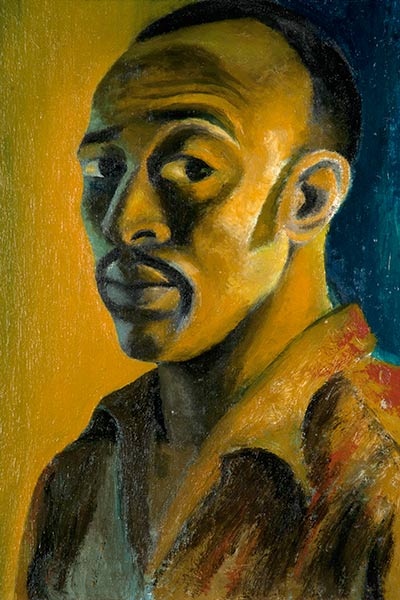A new exhibition in Paris celebrates the presence and influence of 150 Black artists in France between the 1950s and 2000.
To those familiar with the Présence Africaine Review and Revue Noire, Gerard Sekoto, Wilson Tibério, Ben Enwonwu, or Ernest Mancoba are household names. However, their artistic creations have hardly been on display in France before. And this goes for most of the works by the 150 artists now represented at the Centre Pompidou.
Sekoto’s 1946 self-portrait has become the face of the exhibition, displayed prominently on the façade of the museum and on billboards across the French capital. In an interview with the South African Daily Maverick, Barbara Lindop—author of a book on Sekoto’s life and a close friend of the artist—remarks: “That expression I see of Sekoto (…) is one I remember well. He was acutely aware of the human condition, and his eyes tell us, even now, that there is so much more he wants to say.” In a letter to Lindop, Sekoto wrote: “What you are reading from my expression is not fear, but mostly mistrust and deep agony about contradicting attitudes among people.”
Sekoto never returned to South Africa. He died in Paris in 1993 at the age of 80.
Far away from home, Sekoto and fellow African artists helped to define modern art in France. Lindop: “If there is an underlying theme in this exhibition, it is that art born out of alienation, discrimination and relocation—like that forged by exiles in Paris—produces an ethnic cross-pollination of ideas and art forms. In this case, it has influenced the fabric of postmodern art forever.”
“Black Paris” offers a vibrant immersion in a cosmopolitan city—a place of resistance and creation that gave rise to a wide range of practices, from a new awareness of identity to the search for transcultural artistic encounters. From international and Afro-Atlantic abstractions to surrealism and free figuration, this historical voyage reveals the importance of artists of African descent in the redefinition of Modernisms and Postmodernisms.
Four installations by Valérie John, Nathalie Leroy Fiévee, Jay Ramier, and Shuck One, produced specifically for the exhibition, punctuate the visit and offer contemporary insights into this memory. At the centre, a circular matrix draws on the motif of the Black Atlantic, with the ocean as a disk—a metonym for the Caribbean and the “Whole-World,” a term coined by Martinican poet Édouard Glissant, serving as a metaphor for the Parisian space. Attentive to circulations, networks, and friendships, the exhibition presents a living and often entirely new map of Paris.
More information, including video and podcast, & tickets.
Echoing Black Paris
Numerous art, cultural, and educational venues across Paris and Île-de-France are hosting events that resonate with the themes of the "Black Paris" exhibition. Discover the full program below, or allow yourself to be guided through contemporary Black Paris, tracing the African diaspora and Afro-descendant influences. Explore a curated selection of cultural venues, restaurants, and designer boutiques, all brought to you by the expertise of Little Africa.


